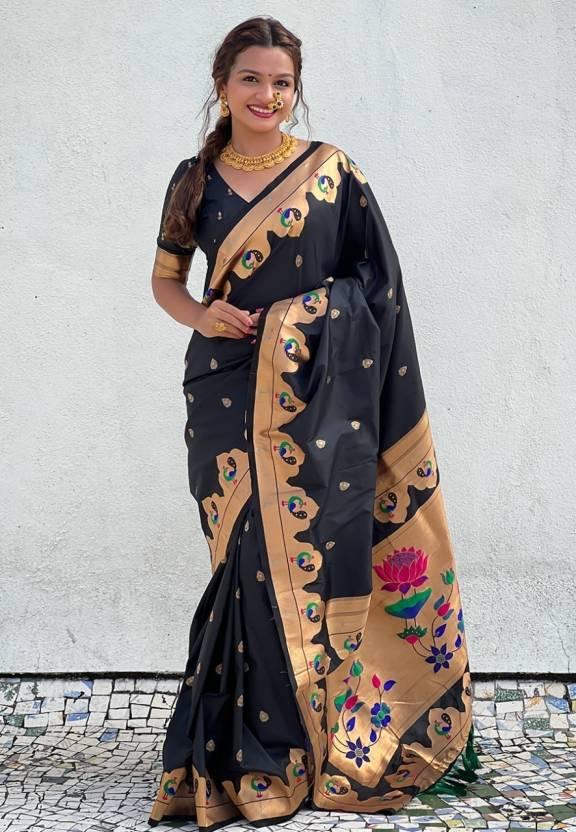India, a land of rich heritage and diverse textile traditions, is home to numerous exquisite weaves, and the Paithani saree is one such masterpiece. Hailing from the town of Paithan in Maharashtra, this luxurious silk saree has been a symbol of opulence, grace, and fine craftsmanship for centuries. With its vibrant colors, intricate designs, and pure gold and silver zari work, the Paithani saree continues to be a treasured possession for women across generations.
A Glimpse into History
The origins of the Paithani saree trace back to more than 2,000 years ago, during the Satavahana dynasty. It is believed that Paithan was a major trade hub on the silk route, and the art of weaving fine silk with intricate patterns flourished under royal patronage. Over time, the saree became a favorite among the Peshwas, Maratha queens, and elite women, further solidifying its status as a prestigious attire.
The Weaving Process: A Labor of Love
Crafting a Paithani saree is an elaborate and time-intensive process, often taking weeks or even months to complete. It involves:
-
Selection of Silk: High-quality mulberry silk is used for both the warp and weft.
-
Zari Work: The borders and pallus are adorned with gold and silver zari, giving the saree its signature grandeur.
-
Handloom Weaving: Unlike machine-made fabrics, Paithani sarees are meticulously handwoven, ensuring each piece is unique.
-
Traditional Motifs: The designs often feature peacocks, lotuses, vines, parrots, and geometric patterns inspired by nature and heritage.
Distinct Features of a Paithani Saree
-
Vibrant Colors: Traditionally, Paithani sarees come in hues of rich green, royal blue, deep purple, red, magenta, and golden yellow.
-
Reversible Border: One of its unique aspects is that the border looks the same on both sides.
-
Intricate Pallu Designs: The pallu (end piece) is heavily decorated with detailed motifs, making it the highlight of the saree.
-
No Loose Threads: Unlike embroidered sarees, the patterns in Paithani are woven directly into the fabric, leaving no loose threads.
Types of Paithani Sarees
Paithani sarees come in different varieties based on their motifs and color combinations. Some popular ones include:
-
Bangdi Mor Paithani: Features peacock designs resembling bangles.
-
Brocade Paithani: Has an intricate, ornamental pallu with heavy zari work.
-
Muniya Paithani: Recognized for parrot motifs on the borders.
-
Lotus Paithani: Inspired by lotus flower patterns.
Styling a Paithani Saree
A Paithani saree is often worn for weddings, festive occasions, and special celebrations. Here are some tips to style it elegantly:
-
Pair it with a traditional gold jewelry set like a choker, jhumkas, and bangles.
-
Opt for a classic bun hairstyle adorned with gajra (jasmine flowers).
-
Choose a matching silk blouse with intricate embroidery for a regal look.
-
Wear a nath (Maharashtrian nose ring) for an authentic touch.
Caring for Your Paithani Saree
To preserve its beauty, a Paithani saree requires delicate care:
-
Dry clean only to maintain the fabric and zari work.
-
Store in a muslin cloth to prevent moisture damage.
-
Avoid direct sunlight to retain its original colors.
-
Refold periodically to prevent creases from becoming permanent.
Why Every Woman Should Own a Paithani Saree
A Paithani saree is not just an outfit; it is a piece of heritage, artistry, and timeless beauty. It carries the legacy of skilled artisans who put their heart and soul into weaving this fabric of dreams. Whether passed down as a family heirloom or purchased as a treasured addition to a wardrobe, a Paithani saree remains an evergreen symbol of grace and culture.
If you are looking to invest in an elegant and traditional saree that embodies luxury and history, a Paithani saree is undoubtedly the perfect choice. It is a masterpiece that never goes out of style!


